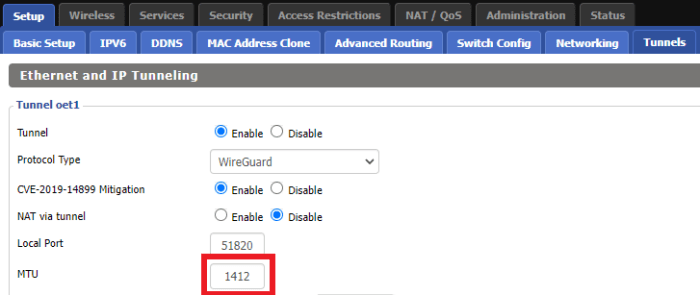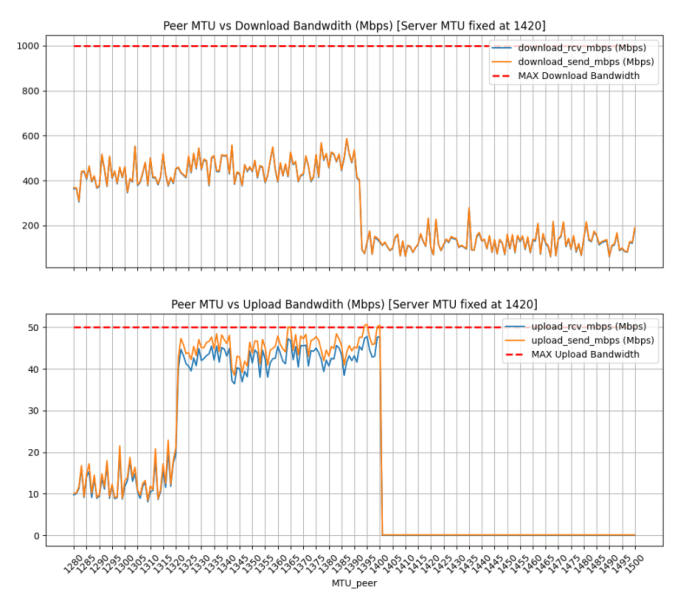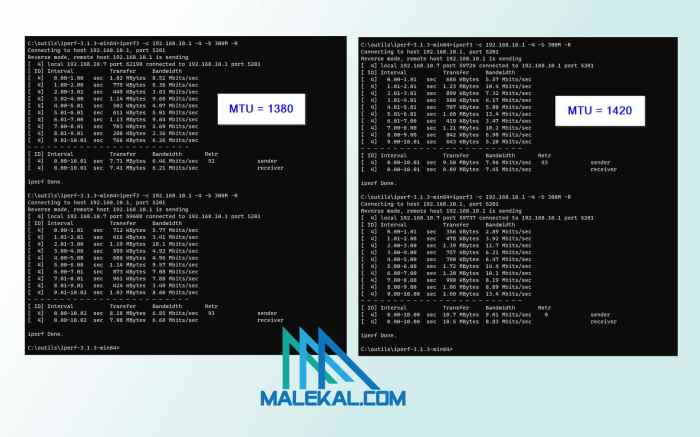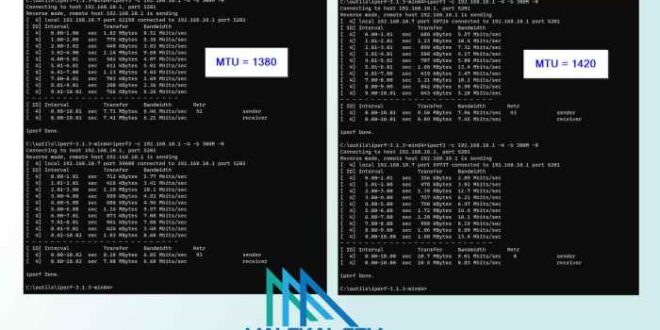In the realm of secure and efficient networking, WireGuard stands out as a cutting-edge VPN technology. At its core lies a crucial concept: MTU (Maximum Transmission Unit). Understanding and optimizing MTU is essential for unlocking WireGuard’s full potential, maximizing performance, and maintaining robust security.
MTU defines the maximum size of data packets that can be transmitted over a network. It plays a pivotal role in WireGuard’s performance, affecting everything from latency to throughput. This guide will delve into the intricacies of WireGuard MTU, empowering you to configure, optimize, and troubleshoot MTU settings for seamless and secure networking.
Understanding WireGuard MTU
Maximum Transmission Unit (MTU) plays a crucial role in WireGuard’s performance and efficiency. MTU defines the largest packet size that can be transmitted over a network interface. In WireGuard, the default MTU is 1420 bytes, which is smaller than the standard Ethernet MTU of 1500 bytes.
Impact of MTU on WireGuard Performance
MTU has a significant impact on WireGuard’s performance in several ways:
- Packet Fragmentation: When the packet size exceeds the MTU, it is fragmented into smaller packets. This fragmentation process introduces additional overhead and can degrade performance, especially on high-latency networks.
- Packet Loss: Fragmented packets are more susceptible to loss during transmission. If a single fragment is lost, the entire packet must be retransmitted, leading to increased latency and reduced throughput.
- Performance Optimization: Setting the MTU to a value that matches the underlying network’s MTU can optimize WireGuard’s performance by minimizing fragmentation and packet loss.
MTU Discovery Mechanisms
WireGuard employs several MTU discovery mechanisms to optimize packet fragmentation and ensure efficient data transmission. These mechanisms vary in their approach and effectiveness, each with its own advantages and drawbacks.
Path MTU Discovery
Path MTU Discovery (PMTUD) is a standard mechanism that relies on ICMP error messages to determine the maximum transmission unit (MTU) along a network path. When a packet is too large to fit within the MTU of a router or link, the router sends an ICMP “Packet Too Big” message back to the sender.
The sender then reduces the packet size and retransmits it. This process continues until the packet can be successfully transmitted without fragmentation.
PMTUD has the advantage of being widely supported and relatively simple to implement. However, it can be slow and unreliable, especially in networks with asymmetric paths or firewalls that block ICMP error messages.
RFC 4821 MTU Discovery
RFC 4821 MTU Discovery is another standard mechanism that uses the IP Don’t Fragment (DF) bit to determine the MTU. When a sender sets the DF bit in a packet, the packet must not be fragmented. If a router encounters a packet with the DF bit set and an MTU smaller than the packet size, it will drop the packet and send an ICMP “Destination Unreachable” message with a “Fragmentation Needed and DF Set” code.
RFC 4821 MTU Discovery is more efficient than PMTUD because it does not rely on ICMP error messages. However, it requires support from both the sender and receiver, and it can be problematic in networks where firewalls or other devices remove the DF bit.
WireGuard-Specific MTU Discovery
WireGuard implements its own MTU discovery mechanism that combines elements of PMTUD and RFC 4821 MTU Discovery. When a WireGuard peer sends a packet with a payload size larger than the MTU, the receiving peer sends a “Too Big” message back to the sender.
The sender then reduces the packet size and retransmits it. This process continues until the packet can be successfully transmitted without fragmentation.
WireGuard’s MTU discovery mechanism is efficient and reliable, and it does not require support from the underlying network infrastructure. However, it is only supported by WireGuard peers, so it may not be suitable for use in networks that include non-WireGuard devices.
Configuring MTU in WireGuard
Configuring MTU in WireGuard is essential to ensure optimal performance and prevent network issues. It involves setting the maximum size of packets that can be transmitted over the WireGuard interface.
Setting MTU in WireGuard
To set MTU in WireGuard, you can use the following steps:
- Edit the WireGuard configuration file: Locate the WireGuard configuration file, typically named “wg0.conf” or “wireguard.conf”.
- Add the MTU setting: Add the following line to the configuration file, replacing “1420” with your desired MTU value:
- Save and restart WireGuard: Save the configuration file and restart the WireGuard service using the appropriate command for your operating system (e.g., “sudo systemctl restart wg-quick@wg0”).
MTU = 1420 MTU Options in WireGuard
WireGuard offers several options for setting MTU:
- Auto-discovery: WireGuard automatically negotiates the MTU with the peer, ensuring compatibility with different network environments.
- Fixed MTU: You can set a fixed MTU value in the configuration file, providing consistent performance but may not be optimal for all scenarios.
- Maximum MTU: WireGuard supports a maximum MTU of 65,535 bytes, which is not recommended for most use cases due to potential performance issues.
MTU Optimization
Optimizing the MTU is crucial for maximizing the performance of WireGuard connections. By carefully selecting an appropriate MTU size, you can minimize packet fragmentation and improve overall throughput.
When choosing an MTU size, several factors should be considered:
- Network Interface MTU: The MTU of the network interface used for the WireGuard connection. This value is typically set by the operating system and can be obtained using commands like “ifconfig” or “ip link show”.
- Path MTU: The smallest MTU along the entire network path between the WireGuard peers. This can be determined using tools like “ping
-s” or “traceroute
-d”. - Application Requirements: The MTU size may need to be adjusted based on the specific requirements of the applications running over the WireGuard connection. For example, large file transfers may benefit from a larger MTU.
MTU and Fragmentation

MTU plays a crucial role in fragmentation, which occurs when packets are too large to fit through a network interface. In WireGuard, fragmentation can significantly impact performance.
When a packet is fragmented, it is broken into smaller pieces that can fit through the network interface. However, this process adds overhead and can introduce latency and packet loss. The optimal MTU is the largest possible size that can be sent without fragmentation, maximizing performance.
Consequences of Fragmentation
- Increased latency: Fragmentation introduces additional processing steps, delaying packet transmission.
- Packet loss: Fragmented packets can be dropped if any of the fragments are lost in transit.
- Reduced bandwidth: Fragmentation overhead reduces the effective bandwidth available for data transmission.
MTU and Network Performance
MTU plays a crucial role in determining the overall performance of a network. When MTU settings are configured appropriately, it can enhance network efficiency, minimize latency, and optimize throughput.
Latency refers to the time it takes for data to travel from one point to another on a network. Higher MTU values can reduce latency by allowing larger packets to be transmitted, reducing the number of packets required to send the same amount of data.
Throughput measures the amount of data that can be transferred over a network in a given amount of time. Properly configured MTU settings can improve throughput by reducing packet fragmentation, which occurs when packets are too large to fit within the MTU and must be broken into smaller fragments.
Fragmentation adds overhead to the network, slowing down data transfer.
MTU and VPN Performance
The MTU setting in a VPN configuration plays a crucial role in determining the overall performance of the VPN connection. It affects both the connectivity and the speed of the VPN.
Impact on Connectivity
An improperly configured MTU can lead to VPN connectivity issues. If the MTU is set too high, it can cause fragmentation of data packets, which can result in packet loss and connection drops. Conversely, if the MTU is set too low, it can limit the maximum packet size that can be transmitted, leading to reduced bandwidth and slower speeds.
Impact on Speed
The MTU setting also impacts the speed of the VPN connection. A higher MTU allows for larger data packets to be transmitted, which can reduce the overhead associated with packet fragmentation and reassembly. This can result in improved throughput and faster VPN speeds.
MTU and Security
MTU settings can have potential security implications. Understanding these implications is crucial for securing your network.
A properly configured MTU can improve security by preventing fragmentation, which can make it more difficult for attackers to exploit vulnerabilities. Conversely, an incorrectly configured MTU can compromise security by introducing vulnerabilities that attackers can exploit.
MTU and Fragmentation
Fragmentation occurs when a packet is too large to fit within the MTU of the network interface. When this happens, the packet is broken into smaller fragments and sent separately. Fragmentation can introduce security risks because it can create opportunities for attackers to intercept and manipulate the fragments.
By configuring the MTU appropriately, you can prevent fragmentation and reduce the risk of attacks that exploit fragmented packets.
MTU and Path MTU Discovery
Path MTU Discovery (PMTUD) is a mechanism that allows hosts to automatically discover the MTU of the path between them. PMTUD can be used to improve security by ensuring that packets are not fragmented unnecessarily.
However, PMTUD can also be used by attackers to probe the network and identify potential vulnerabilities. By disabling PMTUD, you can reduce the risk of attacks that exploit PMTUD.
MTU and Troubleshooting

MTU issues can manifest in various ways, including:
- Slow or unreliable network connections
- Packet fragmentation and loss
- VPN connectivity problems
- Error messages indicating MTU issues
Troubleshooting Tips
To resolve MTU issues, follow these troubleshooting steps:
- Check MTU settings: Verify that the MTU values on all network interfaces are consistent and appropriate for the underlying network infrastructure.
- Use MTU discovery mechanisms: Utilize WireGuard’s MTU discovery mechanisms to automatically determine the optimal MTU.
- Adjust MTU manually: If automatic MTU discovery fails, manually adjust the MTU to a lower value until connectivity is restored.
- Test with different MTU values: Experiment with different MTU values to find the optimal setting for your network.
- Check for network congestion: Excessive network congestion can lead to MTU-related issues. Monitor network traffic and identify potential bottlenecks.
- Consider using a VPN: A VPN can help mitigate MTU issues by encapsulating traffic within a secure tunnel.
MTU in Different Operating Systems
MTU settings and handling can vary across different operating systems. It’s crucial to consider OS-specific nuances to optimize network performance.
Windows
Windows typically sets MTU automatically based on network interface capabilities. However, manual adjustments may be necessary in certain scenarios, such as when using VPNs or connecting to specific networks.
Linux
Linux distributions generally provide more granular control over MTU settings. Network interfaces can be configured individually, allowing for precise optimization. Additionally, Linux supports advanced MTU discovery mechanisms, such as Path MTU Discovery (PMTUD).
macOS
macOS handles MTU similarly to Windows, with automatic assignment based on network interface characteristics. However, certain network configurations or VPN usage may require manual adjustments to ensure optimal performance.
Closing Summary

In conclusion, WireGuard MTU is a multifaceted aspect that profoundly impacts performance, security, and overall network efficiency. By comprehending the principles Artikeld in this guide, you can confidently configure, optimize, and troubleshoot MTU settings to harness the full capabilities of WireGuard.
Remember, a well-tuned MTU is the key to unlocking a secure and lightning-fast VPN experience.
